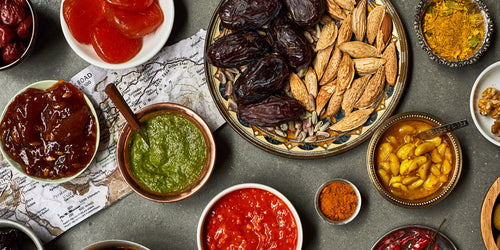Your Cart is Empty
What is it about cumin? I love its earthy aroma. I like the simple act of toasting it to release its fragrance, and grinding it to a coarse powder with a mortar and pestle. Of course, I love the taste of it too, in just about everything. I’m not alone; cumin has been a popular ingredient in countless cuisines for thousands of years.
A global spice
Cumin is grown across the world and is the planet’s second most popular spice after black pepper.
Its origins date back to Biblical times. In Egypt, cumin was used both in cooking and as part of the embalming process. In Greece it was a table spice, like black pepper. In Rome, it wasfrequently mentioned in Apicius as a luxury ingredient for the aristocracy, to be served with snails as well as peacocks and other fowl, or mixed into honey-vinegar sauces.
The spice’s medicinal value was known even then. In Egypt and elsewhere, cumin was often recommended for indigestion, among other ailments. As a folk medicine over the centuries, it has continually been used in decoctions and beverages. Modern research suggests cumin may have antioxidant, anti-inflammatory, and possibly anti-carcinogenic properties.
During the Middle Ages, cumin, pepper, and other spices were traded for other treasured goods and often used as currency. Cumin was introduced to the Americas by Spanish and Portuguese colonists and explorers. Today, it would be hard to imagine food in the Southwestern U.S., Latin America, and Caribbean without it.
You can also find cumin in the cooking of the entire Levant region, as well as North Africa, and parts of Northern China. The majority of the world’s cumin is used in India, where it figures prominently in all regions of the country, in ground spice mixtures of all types or roasted whole.
With an extended family
Cultivated cumin, Cuminum cyminum, is pale brown with a hint of green. It should not be confused with caraway, which it resembles, but which has an entirely different flavor.
Another type of cumin, Bunium persicum, known as black cumin, or kala jeera in Hindi, has smaller, finer, darker seeds, and a more delicate flavor. Its origins are in Kashmiri cooking and palace cuisine. Black cumin is mostly used whole, rather than ground, and is often roasted or sizzled in oil and added to biryanis, breads, chutneys, and curries. (Beware, though, sometimes black nigella seeds are labeled black cumin.)
You can also try similar-sized wild-foraged cumin, Bunium bulbocastanum, sourced in Afghanistan, which is difficult to find but very aromatic.
How to use cumin
Cumin is sold both in whole seed form or ground into a powder, but unless you need vast quantities, it is best to make your own ground cumin. With whole seeds, you have the option of toasting them before grinding, which intensifies their flavor.
When toasting cumin, use a dry pan over medium-high heat, and shake the pan or stir the seeds constantly for the minute or two it takes to complete the task; otherwise you risk burning them. Err on the lighter side. Then grind them in a mortar (I like to use a Japanese suribachi, great for making a coarse-textured powder) or use an electric spice mill.
Now you are set to make cumin salt, which is great sprinkled on everything from sliced tomatoes to fried eggs. It is divine with lamb—steamed lamb shoulder, grilled lamb skewers and chops or, for the adventurous eater, boiled lamb head. Use it as a seasoning for roasted, braised, or boiled chicken, too. I always like to keep a little bowl of it on the table.

To make it, simply stir together one teaspoon toasted ground cumin and three teaspoons of flaky sea salt. Add hot red pepper flakes or cayenne to render it spicy. Vary all proportions to suit your own taste.
Cumin salt is a useful all-purpose seasoning for many North African dishes. But Paula Wolfert writes about Moroccan families offering separate bowls of salt and cumin at their communal tables, so diners can adjust the balance to suit their own tastes.
In my most recent book, David Tanis Market Cooking, there is a recipe for a traditional Indian red lentil dal, which uses cumin to great advantage. While the lentils are cooking a spoonful of dry-toasted cumin seeds is added, along with diced onion and a little turmeric. But just before the dal is finished, a spoonful of raw cumin seeds are sizzled in ghee with some chopped garlic and hot chile in a technique called tarka. This fragrant buttery mixture is swirled into the lentils, giving a second hit of cumin that really brings everything together, without overpowering the other ingredients.
Cumin’s flavor is sometimes described as bitter or peppery; there are some people who can’t abide its aroma. I find its robust flavor to be sweet and earthy. For me, it is a favorite spice that always adds interest, warmth, and depth.
Get cooking with cumin
Recipe: Red lentil dal
Recipe: Cumin lamb pitas








